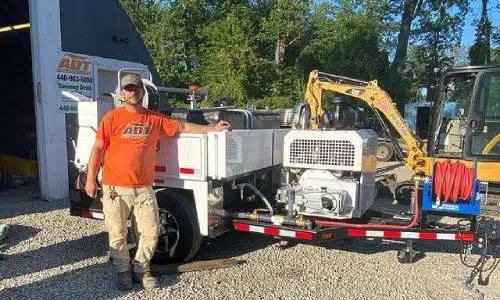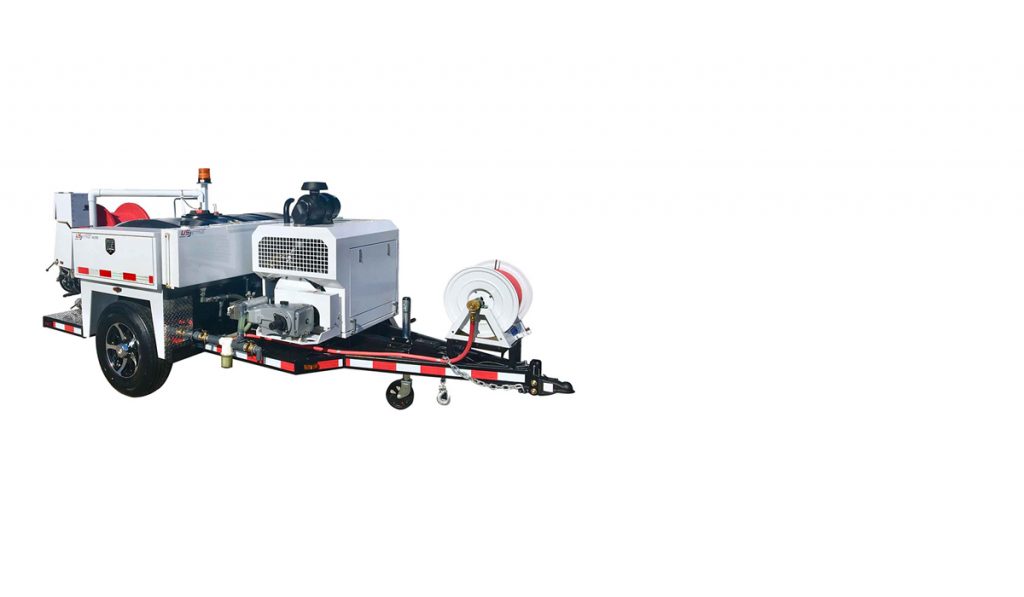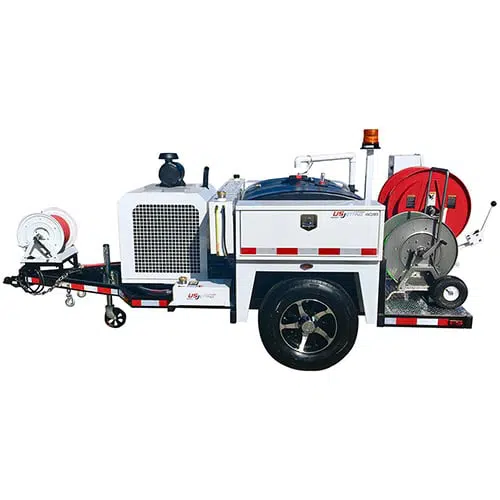
It’s the Most Wonderful Time of the Year…To Check Your Pump
As we head into winter, it becomes increasingly important to regularly service and maintains your jetting unit, so your jetting company doesn’t have to contend

If you are thinking of getting into the jetting business or upgrading your small unit to something more substantial, there are a lot of sewer jetter units out there to choose from. It’s a big purchase and you make your decision only after fully understanding what you need from your machine and what applications it is best for. To determine this, you should answer the questions below.
From the home to the main sewer, residential pipes sizes generally range from 4” to 6”, and the average length of pipe is 75 to 100 ft. For a jetter than handles only these types of pipes, you could consider a 3000PSI at 12GPM unit. This hydro jetting machine requires 23HP to drive it, and it will handle 4” to 6” pipes, which makes it a good beginner unit for residential and light commercial clients. They can probably open bigger pipes, but will have trouble cleaning them thoroughly. If your main work is residential, then this jetter would be sufficient for you.
The next size up from this unit would be 4000PSI at 12GPM, which requires 30HP to power it. This unit will do a better job of grease and root removal with the extra 1000PSI. Remember, what you see on the pressure gauge is not what you get at the end of the hose. The pressure gauge is measuring pressure at the pump, while at the end of the hose it will be less, depending on the size and length of the hose.
The next step up would be the 4000PSI at 18 GPM, which is the most popular unit for contractors. It can handle heavy-duty residential and commercial jobs in addition to the smaller lines. While the smaller units are often gas-powered, this unit takes a 50 HP diesel-powered engine and can tackle any pipes up to 18” with the right nozzles. Some of our competitors offer two 25HP gas engines driving two 9GPM pumps and claim it’s a 4000PSI at 18GPM unit, however, it’s important to keep in mind this is now two engines and two pumps that need maintenance. US Jetting 4018 units usually come with 500 ft of ½” hose and 300 or 600 gallons of water storage. These drain jetting machines have some of the best resale values on the market, and many customers use them for 20+ years.
Main sewer lines average around 10” to 12”, culverts sizes are about 12” to 18”, and storm drains are usually 18” to 36”. To tackle pipes these sizes, the 74 HP diesel unit producing 4000PSI at 25GPM is a great option. This is a very powerful machine that can handle large pipes and small pipes for maximum versatility. It comes with 500 ft of 5/8” hose, but smaller hoses down to ¼” can be attached to tackle small pipes.
For those that like the idea of using a higher volume of water, especially in the larger pipes, a 3000PSI at 30 or 36 GPM is another very good option. These come with 500 ft of 3/4” hose, but have to have larger water tanks to keep up with the demand. These are often truck mounted or come as tandem axle trailer units.
In addition to pipe sizes, the type of debris you want to tackle will be important when considering which high-pressure jetting machine to buy. If you’re tackling roots, grease, general cleaning, and descaling then you want a higher PSI and lower gallons per minute.
It’s important to pair your pressure appropriately with your flow in order to efficiently clean your pipes. For example, if you’re in 4-6” lines with heavy roots or grease, then you would need a minimum of 4000 PSI with 18 GPM. If you’re trying to remove sediment such as sand, rocks, or mud, then you need less pressure and more volume to push the debris down the pipe.
When jetting, it is ideal to jet upstream. Therefore you want to be able to jet from one manhole upstream to the next one. Then you proceed to that manhole and continue on your upstream journey. To do this efficiently, you want a hose length that can reach from one manhole to another. The common length between manholes is 300 to 500 ft, which is why most US Jetting units are equipped with 500’ of hose.
Municipal units tend to be high volume (30GPM+) and lower pressures (2000-3000PSI). These are good flushing units, but also require quite large hoses from ¾” to 1” and can easily flood small pipes if not used carefully. They are ideally suited for larger pipes above 12” and manhole to manhole work.
Hot water is unnecessary unless you are doing mostly pressure washing. In fact, hot water is a detriment to drain cleaning for several reasons. The jetting unit requires so many hundred thousand BTU’s to get the water hot, and the added expense would be better put towards a higher pressure unit with the right volume rather than hot water. The idea that hot water will melt grease better is invalid, as you want to break the grease up with cold water to keep it flowing. Hot water simply melts it, only to have it reform as it cools further down the pipe. Plus, if you are going to camera the pipe after cleaning with hot water, you have to wait for the fog to dissipate before you can see anything in the pipe. Special hoses are also needed to handle anything above 125 degrees, and as a result, are even more dangerous if a hose ever bursts.
The answer to this will determine whether a wireless remote control is needed. Wireless remote controls enable one man to operate a jetting unit without extra help. The operator can stop and start the engine, turn the water on and off, and raise and lower the water pressure all with a wireless remote. However, it is still advisable to have a two man crew until you have become completely familiar with the hydro jetter machine.
Once you have determined what your needs are, it is time to consider price and unit size. Our suggestion is always to go with something just a bit bigger than you think you need, to allow for growth. A lot of people will just look at the cost, which is important, but not the most vital aspect. Getting the machine that is going to do the job is the most essential part. If you get a high-pressure jetting machine based on the price, and it doesn’t do the job, then you are back at square one. Hydro jetting units are revenue
generators that pay for themselves very quickly so it is important to get the right one at the beginning. Lastly, warranty terms and local service are important factors in decision-making. Investing your money in a US Jetting machine allows you to comfort of knowing you have purchased a machine that we stand behind for not only warranty but long-term troubleshooting and advice. Our customer service and nationwide services centers are built to foster long-term relationships with all of our customers, so they can rest easy knowing they made the right purchase.

As we head into winter, it becomes increasingly important to regularly service and maintains your jetting unit, so your jetting company doesn’t have to contend

Having spent a few years as a jetting contractor and manufacturing hydro jetting units for the last 35 years, I have come across all sorts

Main Office:
850 McFarland Pkwy, Alpharetta, GA 30004 Local: 770-740-9917 | Fax: 770-740-0297
California Location:
13571 Larwin Circle, Santa Fe Springs, CA 90670 Sally Woodhead: 404-936-1718 | 562-376-4656